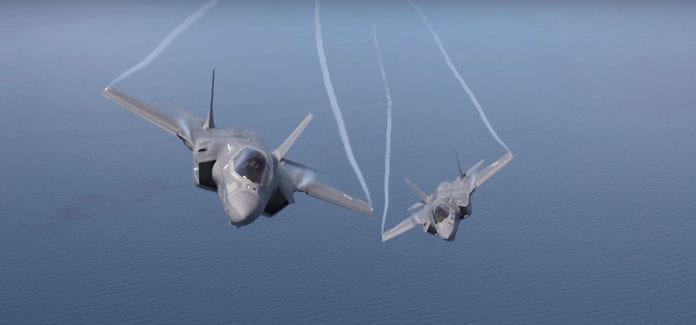Lockheed Martin turned to 3D technology and big data to streamline the diagnostics and maintenance processes for its F-35 and F-22 fighter planes, according to a case study provided by the Industrial Internet Consortium

The F-35 Lightning II is a family of fifth-generation stealth aircraft developed by Lockheed Martin designed for the nine participating nations in the Joint Strike Fighter (JSF) program, the largest cooperative of its kind since World War II.
Lockheed Martin not only designed and is building the F-35, it also delivers F-35 sustainment support, which includes training, prognostics and maintenance with the goal of helping military customers improve on-the-job support, while prolonging equipment life and maximizing the aircraft’s operational availability.
Tiny details can mean the difference between life and death
It goes without saying that the accurate assessment of the mechanical structure of an aircraft after combat or environmental hazard is crucial. Even small factors — such as the depth of a scratch or the distance of a hole from supporting structures — can impact flight-worthiness, aircraft stealth capability and pilot safety.
In order to ensure the proper maintenance of all these small details, Lockheed Martin looked to streamline its damage and assessment process for the F-35.
They wanted to move away from the traditional way of doing things, with maintenance technicians manually assessing and tracking damaged areas by placing a transparent film over these areas and tracing reference points, like seems or fasteners, with a marker, and cross-referencing the information with repair data history in a spreadsheet. The problem with cross-referencing line drawings is that it does not provide the optimal platform to visualize repair information, it is also cumbersome and time consuming, leaving more room for maintenance errors, according to Lockheed Martin.
A big data fix
To improve maintenance efficiency and accuracy, Lockheed Martin engineers adopted interactive 3D technology to integrate into their existing information infrastructure, or the Autonomic Logistics Information Systems (ALIS) software suite. The interactive technology was put in place to streamline operations, maintenance, prognostics, supply chain and customer support services data.

The solution, according to NGRAIN, needed to:
- Provide accuracy within 1/10th of an inch
- Allow complex 3D datasets to run interactively on tablet computers
- Be user friendly for flight line maintainers.
The solution was provided by NGRAIN, a company that provides visualization and simulation solutions, to transform its damage assessment and repair system. NGRAIN developed the industry’s first interactive 3D Virtual Damage Repair and Tracking solution and came up with a solution that allows aircraft maintainers to capture damage information within a detailed 3D virtual model of the aircraft.
Lockheed Martin benefited from NGRAIN’s volume graphics technology, rendering performance on laptops and software development kit (SKD).
How it works
When working with the damage assessment solution, a technician specifies the aircraft tail number, or its unique identifier. The solution recognizes this number and immediately displays historical damage and repair data for that particular aircraft. The technician then enters data like damage type and dimensions.

Maintenance workers can use the solution to identify location of damage, insert photos and notes and visually locate parts for ordering. The virtual damage assessment software is delivered on portable, ruggedized computers, and works with other software applications to help maintainers quickly assess whether or not damages adversely impact aircraft mission capability. It also helps maintainers determine which damages need to be repaired to restore the aircraft to mission capability.
The solution was first delivered with F-35 aircraft to United States Air Force (USAF) test sites, and is now being deployed to aircraft procured by other nations participating in the JSF program.
If it works, keep using it
Lockheed Martin again selected NGRAIN to configure its software for F-22 maintenance. As part of the project, NGRAIN modified the solution for F-22 part numbers and identifiers. In addition to helping maintainers track and record exterior aircraft damage, the F-22 NGRAIN solution allows technicians to view the interior of wing inlets. NGRAIN engineers also configured the solution for Lockheed’s Integrated Maintenance Information System (IMIS), a software suite that acts as the “information backbone” for the F-22.

“The fact that NGRAIN is the only supplier outside of the US that has ever worked on the F- 22 is a testament to the F-35 tracking and repair solution’s effectiveness,” said Jeff Babione, vice president of the F-22 program.
Making crucial repairs easier to find
U.S. Airforce maintainers said they can now easily visualize damage repair data thanks to the newly integrated technology, and that they appreciated having immediate access to historical aircraft information post-operations, according to NGRAIN. This has helped maintainers save time and reduce the maintenance time-to-flight hour ratio.
Traditional methods, involving line drawings and cumbersome spreadsheets, have been replaced with streamlined processes integrated with back-end software systems. According to NGRAIN, these virtual damage assessment solutions, aircraft maintenance technicians can:
- Increase Operational Availability of Equipment: When an aircraft lands, maintainers on the flight-line can connect to the database and immediately determine whether the aircraft is flight-worthy.
- Work More Efficiently with Fewer Personnel: Using a streamlined process, maintainers can reduce the time required to document, assess and repair damage. In the case of the USAF, because the F-35 and F-22 solutions have similar workflow, aircraft maintainers can easily transition between the two platforms.
- Capture Data More Accurately: Providing maintainers with the ability to visualize and accurately represent aircraft damage on a 3D model reduces the probability of maintainers making mistakes, which translates into safety for pilots.

